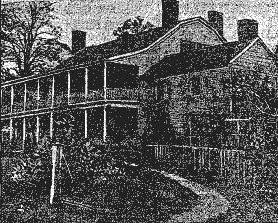Though Maspeth is out of the beaten track of the tourist, once in a while it is visited by a stranger on a travel bent, and as he goes through Spragg's Lane, in the western part of the village, he is sure to ask a question or two about a house of ancient architecture. Any one in Maspeth will at once tell him that it is the old DeWitt Clinton House, for by that name it is known locally, though it is now only a tenement.
It was the residence of the late Judge Jones, whose father, the late Samuel Jones, was called by his illustrious pupil, DeWitt Clinton, the Father of the Bar of New York. At an early age it was the abode of Joseph Sackett, a worthy judge of the Court of Common Pleas, who died at a venerable age, twenty years before the Revolution. Then Walter Franklin, a rich New York merchant, resided there until his death in 1780, and after him Colonel Isaac Corsa, renowned for his chivalry in the French War, and then the eminent statesman, DeWitt Clinton, who married the daughter of Mr. Franklin, and neice of Colonel Corsa, and made the famous mansion his country residence for a considerable portion of his life, and is said to have there planned the stupendous undertaking of uniting the waters of the Erie with the ocean.
During the Revolution, the house was occupied by General Warren of the Royal Army, and General Howe superintended the embarkation of his great army in boats on Newtown Creek, when they crossed over to Kip's Bay and took possession of the City of New York. Later the property was owned by Edward Godfrey, one of the solid men of the leather district of New York City, who, with praiseworthy taste, left unaltered and undisturbed this mansion of many memories. This was more than a quarter of a century ago. Since Mr. Godfrey's ownership, there has been a marked change. The property was sold to others and for years the house has been occupied as a tenement. Another part of the ground is used for a summer picnic park. A hotel and two or three frame dwellings have been built thereon.
The tracks of the Long Island Railroad now pass within a few feet of its southwestern corner and the English Kills on its western boundary has been for years a turbid, ill-smelling stream.
Large manufacturing establishments are almost within its shadows, and relic hunters, time and tenants have made sad havoc of the property and old building.
When the high hill near St. Saviour's Episcopal Church, and near the Clinton House, was removed some years ago, the stump of an old flag pole was found. The Rev. Caleb B. Elsworth, the rector of St. Saviour, since deceased, on commenting on it, remarked that on the hill DeWitt Clinton's followers held their political barbecues, and what appeared to be a log of decaying wood was a piece of a flag pole which was erected by Clinton, for at that height a flag could be seen for miles around.
A few years ago, a stranger appeared at the gates of the old mansion and was refused admission by its owner. After making a strong appeal he was admitted. Before his departure he stated that he was one of the Clintons who was born in the old house, and literally remarked:
'Twas a dream! – not a token or trace could I view
Of the names that I loved, of the trees that I knew;
Like the shadows of night at the dawning of day,
“Like a tale that is told,” they had vanished away.



